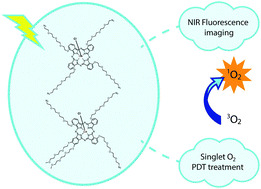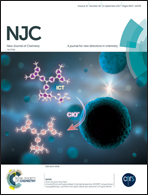Assessment of the relevance of GaPc substituted with azido-polyethylene glycol chains for photodynamic therapy. Design, synthetic strategy, fluorescence, singlet oxygen generation, and pH-dependent spectroscopic behaviour†
Abstract
A new efficient synthetic route was used to obtain symmetrically and asymmetrically substituted gallium(III) phthalocyanines (5-GaCl and 6-GaCl) containing azido groups with chlorine atoms at axial positions, using corresponding ZnPc derivatives (5-Zn and 6-Zn) as precursors. The photophysical and photochemical properties—fluorescence, singlet oxygen generation, and photodegradation—of 5-GaCl and 6-GaCl were compared with that of 5-Zn and 6-Zn. Their pH-sensitive spectral changes were also investigated in detail, as tumours are more acidic than healthy tissues. Their amphiphilicity, quantified by their partition coefficient, appeared suitable for biological applications. 5-GaCl and 6-GaCl exhibited higher photodynamic potential than unsubstituted gallium(III) phthalocyanine, suggesting potential to be used as a photodynamic therapy agent.



 Please wait while we load your content...
Please wait while we load your content...